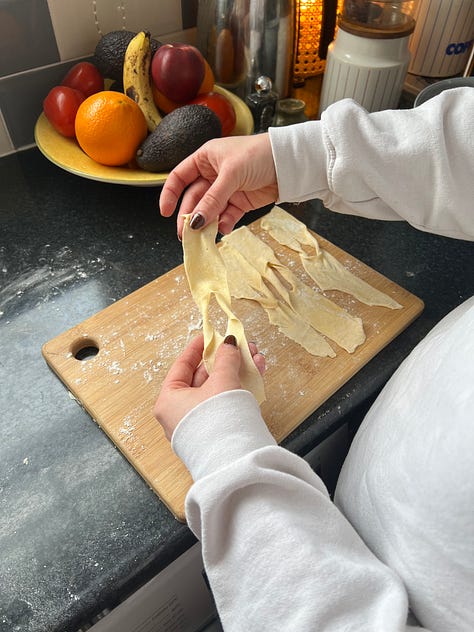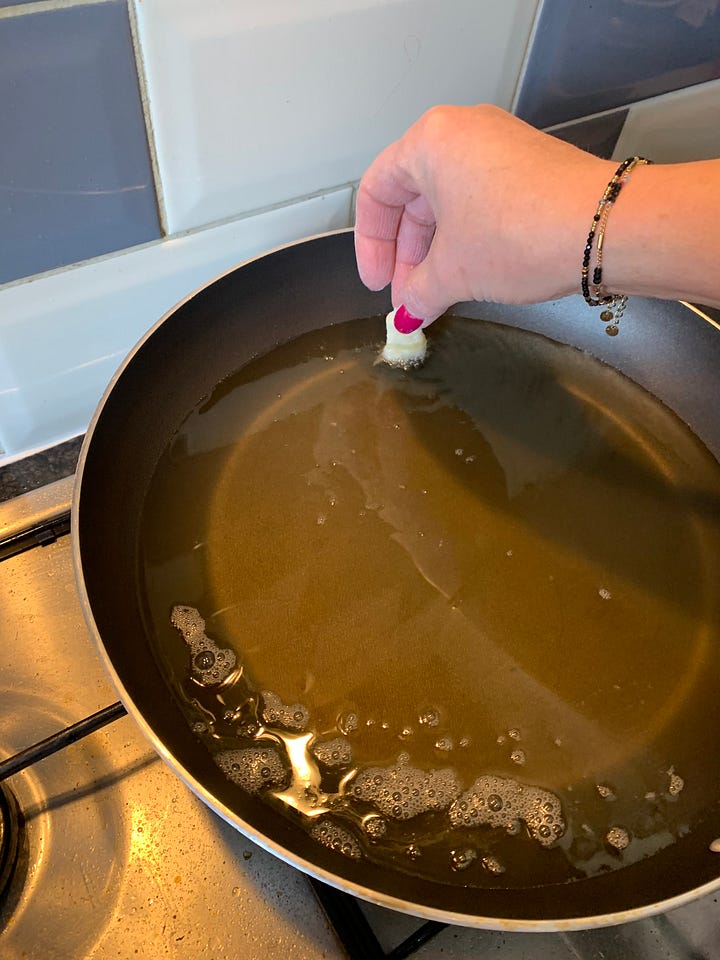Polish Faworki: A Special Carnival Treat
An ode to carnival season, fried pastries and my mum's baking
Guys, we made it. Spring has finally sprung, and in my true Aries nature, I’m ecstatic about all the possibilities ahead. It’s been a bit of a whirlwind these past couple of weeks—overseas visitors, my parents coming for a long weekend, hosting friends for an annual holiday gathering, and stressing over a big deadline at work. This is a convoluted way to explain my absence (mostly to myself). I’ve genuinely been thinking about writing this post almost every day last week but kept running out of time, having to use my writing in a less creative and more bland way at work. But enough about that, let’s focus on where I am right now—on the rooftop of my hotel in Palermo's historic centre, where I’m staying for a week-long holiday. I’m doing some pretty cool food-related things here and can’t wait to tell you all about it in my next food guide, so stay tuned. But for now, let’s talk about one of my favourite times of the year, which actually just came to an end: carnival!
Different cultures have different traditions around carnival. In Poland, we mark it with festivities centered around indulgence and play. As a kid, I loved dressing up for the kindergarten balls in the carnival season. Every year, you got to be a princess or a fairy for a day. One time, my mum dressed me in a red dress and painted my cheeks a little bit too much—though, if you’re familiar with Glossier Cloudpaint, it’s funny how these days, that’s the exact look we’re going for. The more blush, the better. Please enjoy my photo as a ladybird, question mark??
My favourite day of the carnival falls at the end of February—Tłusty Czwartek (Fat Thursday), marking the last Thursday before Lent. It's associated with the celebration of Carnival and the last opportunity for indulgence before fasting in the lead up to Easter. Fat Thursday in Poland usually goes like this: you eat a donut (or four) and enter into a weird contest with your loved ones and strangers about who has eaten more donuts. The one conversation you’re guaranteed on that day is: “How many donuts have you had already?” followed by complaints about weight gain and declarations of cutting off sugar for the rest of the month. Some actually do just that. For example, my parents go sober until Easter. My mum also gives up sweets. It’s something I remember as constant throughout my childhood. That day, you don’t really eat anything else—you simply don’t have space for it. Your keyboard and phone are all sticky from the sugar glaze that covers the donuts you inhale. Because of the sugar high, getting anything done at school or work becomes impossible, but it’s okay because no one expects this of you on that day. Fat Thursday is the one day in the year where all bets are off and life becomes a little bit like a playground. That’s why I appreciate this holiday so much more as an adult. It’s a healthy reminder to make space for a bit of play in our otherwise serious lives.
I started calling it donut day a few years ago when nostalgic about home, I took myself out to Klos Deli — polski sklep (Polish shop) in Lewisham. I bought one donut (rose jam filling, sugar glaze, and candied orange peel on top—my forever order) and then thought better of it and bought one for my bestie and flatmate, who also happened to be Polish. A year later, I went back to Klos, brought home a box of donuts, and invited a few uni friends over for some donuts and board games. By doing this, I found a totally new meaning in this holiday—one that was more about sharing and being proud of my cultural heritage. When I saw how much my friends enjoyed the donuts and our tradition, I felt an immense sense of pride about my country and joy in sharing this with my friends in London. Mind you, this was just after Brexit, when these feelings were often muted. Since then, every year—like clockwork—if you’re in my periphery, you’ve heard me going on and on about donut day. After the world semi-reopened during the pandemic, I went back to that same Polish shop, and it all felt like a dark comedy. Behind the counter, two Polish blokes were commenting on Putin’s invasion on Ukraine, all whilst selling me a dozen donuts, hiding behind face masks, all of us fearful of infecting each other with a deadly virus. By the way, Vittles posted this wonderful essay about a history and cultural significance of polski sklep in London, which I’d recommend.
I brought the donuts back to our house share in Bermondsey, and we hosted a few people who were in our bubble for donuts and wine. Once the world fully reopened, I started hosting what I’d call a donut day party. For one of the first ones in my current flat, we bought 40 donuts and invited everyone we knew. Over the years, I’ve introduced many people to the joy of donuts and that day. A very special shoutout to my bestie Annie, who has never missed a donut party—despite never having tried them due to dietary reasons. THIS is my love language. It warms my heart when I get messages from friends in Liverpool or Berlin telling me they had a donut that day too. This year, one of my guests was about to leave for New York, so I can finally say that donut day went transatlantic. I kept it more intimate this time, hosting a few of my closest girlfriends for donuts, wine, and a book chat. It was the fifth donut day party in London—I wonder what next year will bring and if it will even be in London at all.
Today, however, I want to share a recipe for another deep-fried pastry that has also been a staple in my house during the carnival season—faworki. It feels fitting that I’m writing this post from Sicily, where people also indulge in fried pastries. Just like with carnival, different cultures have their own names and methods for making these sweet, crisp treats. Through an internet deep dive (Wikipedia), I found at least 30 other names for faworki—here are a few of my favourites:
Chilean Spanish: calzones rotos ('torn panties')
Croatian: krostole, kroštule
Czech: boží milosti ('God’s grace')
English: Angel wings
Latvian: žagariņi ('twigs'), zaķauši ('rabbit ears')
Norwegian: fattigmann ('poor man')
Portuguese: crostoli
And of course, Italian:
Italian: chiacchiere ('chatter'), bugie ('lies'), crostoli, frappe, galani, grostoli, sfrappole, nocche.
You can certainly make faworki by yourself, but they really should be a team effort. At least, that’s how I was taught to make them. They are one of my most precious childhood memories—we’d always make them as a family at the end of February, sometimes for several nights in a row. There would be as many faworki as there were platters and countertops in our house. My parents would often invite friends over, and together we’d make faworki late into the night. It was a full-on production.
My dad would knead the dough and roll it out with a rolling pin until it was extra thin. Then, my mum and I would fold the pieces into their signature bow shape. Once everything was ready, she’d take her position by the stove, frying them one by one, always stressing (and repeating) for everyone to stay away from the hot oil. Inevitably, someone would get a minor oil burn in the midst of the chaos. My role was to dust the faworki with powdered sugar as soon as they came out of the pan and were placed on paper towels to soak up the excess grease. A small but mighty task. The rule of thumb? Cover them so generously that your doctor would give you a lecture on diabetes. It doesn’t really matter, though—technically, you’re supposed to fast for the next month anyway. I’ve never pretended to be a baker, in fact, I find it intimidating but I’ve always loved watching my mum bake and helping with the smaller tasks. I’ve assisted her with faworki many times, and last week, all three of us made them together in my London flat.
One of my favourite things about my mum (though there are far too many to count) is the old, yellowed notebook she’s had since her teenage years, filled with recipes she’s collected over time. The faworki recipe, which predates me, lives in that very notebook, alongside poems and random notes. For years, the recipe only existed on that tiny scrap of paper and in my mum’s head, but I finally asked her to write it down. And now, with her permission, I’m so delighted to share it with you.
Faworki
About 4 large platters, that would easily feed 12 people. Hard to tell how many that is exactly.
Ingredients
500 grams of plain flour (universal type 450)
4 egg yolks
4 teaspoons of rectified spirit
4 tablespoons of heavy cream (18%)
2 tablespoons of powdered sugar
A pinch of salt
4 store bought cubes of lard (this animal fat is what is recommend for frying, but you can also use vegetable oil if you’re vegetarian; I think you’d want at least 1l of vegetable oil or enough to cover a big pan)
Powdered sugar for dusting
Tools
Wood pastry board or cleaned kitchen counter
A rolling pin
A sieve
Several large plates and trays
Kitchen towel
Large pan
Method
Start the dough. If it’s too dry, add 1-2 teaspoons of spirit; if it’s too sticky, add more flour.
Knead the dough into a ball, wrap it in cling film, and put it in the fridge for about 30 minutes.
Prepare the pastry board and sprinkle it with flour.
Divide the dough into 6-7 portions. Take the first piece, form a ball, and place it on the pastry board. Pat it a few times with a rolling pin to aerate the dough.
Roll it out, shaping it into an oval/circle. The dough shouldn’t stick to the board, so sprinkle it gently with flour.
Roll the dough very thin—almost like parchment.
Cut into strips about 2.5-3 cm wide and about 15 cm long. They don’t have to be perfectly shaped.
Cut each strip in the middle, about 2 cm. Thread one side through the hole and shape the faworki. Place them on a dusted countertop or tray.



After all are ready, heat the fat in the largest pan you can find. Mum recommends starting to heat it up while rolling out the last batch, which is why she thinks faworki is a team effort.
The temperature of the lard for frying should reach around 210-218 degrees. If you don’t have a kitchen thermometer, check with a piece of dough; when you throw it into the fat, it should fry almost immediately with visible bubbles forming).
When the fat is ready, prepare 2 forks (this is her preferred equipment for turning fried faworki) and fry the pastry, throwing 4-5 into the pan at a time.
After throwing the last one in, quickly turn each one over to the other side.
Once they become golden in colour, quickly move them to a tray lined with a kitchen towel. Don’t over-fry them. Remember that they continue frying for a while after being taken out.
Start frying the next batch immediately. While the other person, moves faworki to a platter or large plate and dusts them with powdered sugar using a sieve. That is why she recommends having at least one other person in this process, as these activities happen at the same time.
Here is the step by step frying process in pictures:




We hope you enjoy them. Ciao! xx










